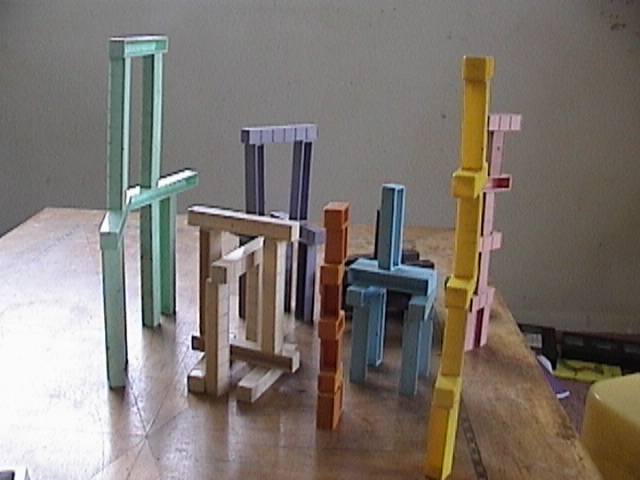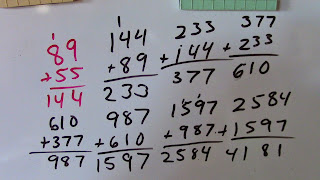Base ten blocks make fractions much easier to understand. The Fractions page on my website is in serious need of an over haul. Eventually I will get to it. Meantime there Are posts like this.
Here we packed more into the hour (but not too much more from the stand point of CONCEPTS), going over the same concepts using fractions tiles and multi-tens, and drawing them with symbols and practicing problems adding up to less than one. Also did a couple subtraction problems. Then ended with a few that were one and some more...next lesson will contain more symbols less blocks and more on improper fractions. All of this and all we learned was adding and subtracting fractions. Multiplication and division of fractions will come another da, and they are just as easy to present and understand using manipulatives.
Please read this from the POV of how you would present it to your students or kids, and note the common stumbling blocks to be avoided. Base ten blocks and manipulatives allow you to avoid the misconceptions in the first place. Starting with the most common misconception, that some how the rules have changed when we get to fractions. They haven't: we can only combine same kind with addition or subtraction.
I have this one kid I would really like to video tape but I don't want to embarrass him, because he consistently shows a basic lack of understanding of CONCEPTS. This is because he has never been exposed to them.
Asked him to add 1/2 +1/3
His answer 1/5. "Because if the tops are the same you just leave them alone and add the bottoms...or is it the other way around?"
When I showed it was 5/6 using manipulatives there was a lot of "ohh!" and "OK" and "I get it" so we went over the 5 basic concepts focusing on they have to be SAME before we can add them...and because he is still lacking in multiplication skills, I used fractions manipulatives to help him practice multiplication (and addition). We could skip count this by 3's or by 4's...put the next over lay on and then we will be counting 5's...etc...you don't have to know your multiplication tables in order to do fractions. Use the fractions to help learn multiplication.
I also asked him during the course of adding fractions which was bigger 1/4 or 1/3...of course he said 1/4.
 |
| Visually Obvious. |
Then before I showed him any of the fractions tiles and asked how many to make a whole one if I have 1/3...he said 3 and how many to make a whole one if I have 4ths?...4 so four is more than three. TRUE. But the more pieces you need the smaller each piece is...puzzled look. But as soon as I get the factions pieces out one look and it's VISUALLY OBVIOUS that 1/4 is the smaller one. "OH!" This child is a teenager.
Not stupid, just never been exposed to math concepts and manipulatives just rules, formula and stuff to memorize long enough to take a test and forget. He is a Classic American Math Student. Had he never met me he could probably have a bright career in climate "science."
We talked about 1/5 and 1/5...how many? 2/5. EASY because they are same. Once we make them the same kind we can add them. x + x is easy because they are same kind...you get 2x. One of something plus another one of the same thing gives you two of something. Easy. But if they aren't same kind we better make them same kind so we can add them. Then we talked about the numerator and the denominator. He had forgotten the name of "the bottom one"...de nom, de name, da kind of it...but he did remember the numerator which tells you how numerous the kind is...
"What kind of math is this?"
"Adding and subtracting fractions. About fourth grade level in most public schools..."
"But for your kids it's like first grade."
"Right."
We did several more problems until he got the hang of it using manipulatives...THEN I moved to drawings...and we stopped there. Tonight his sub-conscious gets a chance to put some things together and then we will work on going from blocks to drawings to symbols. Because he is a teenager I can go much more rapidly than if he were 6 or 7.
Then we talked about improper fractions and did about three of those just to give him a taste, ending with...5/6 + 4/9...could you think of a common denominator?
 |
| Symbols, Drawings and Blocks |
"NO."
So he plays with his sliders on his multi-tens blocks and gets the answer. But still couldn't convert it to 1 and 5/18ths on his own...that's a concept for another day for now one and some more is good enough. Like remembering numbers if you try to remember too many at a time some of them are going to get lost so just a few concepts at a time is best.
Right now the concept of SAME and doing the multiplication is enough. Next I'll add more to that...which will further cement the foundational concepts of making them same before we add them. The rules didn't change we have to understand equivalent fractions and common denominators. With young kids first we play with the tiles then we play with the multi-tens, having multiple lessons in both. With this student he got it all in one lesson because he has more experience and is older and can handle it...if he was 5 we would have done less. Just the one concept of making them same and then practicing adding them using tiles; then maybe some drawing and then some symbols. That might take THREE HOURS. Then on a different day a lesson with multi tens...again another hour or two. Five or six separate classes, spaced out over time.
Using "sliders" is the fun way to do it. Over all kids like using sliders more. If you don't have multi-tens don't worry you can just use base ten blocks out of your combo kit and get them out a pair at a time, kids like this too and it's especially good for the hands on experience, it takes longer though which isn't a problem if you are homeschooling. Just for fun I uploaded this to blogger so it's a video you won't find anywhere else.
Can you also see how easy it is to talk about equivalent fractions and learn skip counting while we do?
For those with dyslexic students not that the image is reversed because I used my lap top's camera for all of these pics, but I am able to "flip' the photos but not the video. And it doesn't matter...base ten blocks level the playing field.
Want some Fractions Worksheets made for base ten blocks?
Percentages usually come next after fraction. Showing how to do percentages with base ten blocks is EZ.
BTW if you want to learn how to use the blocks to teach your kids I have SEVEN Hours up so far, but you need a special PT password. Go here for Parent Teacher Training. $15 bucks such a deal....
“A man is like a fraction whose numerator is what he is and whose denominator is what he thinks of himself. The larger the denominator, the smaller the fraction.” ~Leo Tolstoy








